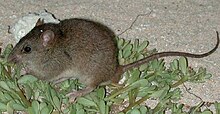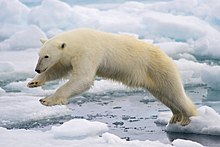Decline in wild mammal populations
Biomass of mammals on Earth as of 2018[1][2]
The decline of wild mammal populations globally has been an occurrence spanning over the past 50,000 years, at the same time as the populations of humans and livestock have increased. Nowadays, the total biomass of wild mammals on land is believed to be seven times lower than its prehistoric values, while the biomass of marine mammals had declined fivefold. At the same time, the biomass of humans is "an order of magnitude higher than that of all wild mammals", and the biomass of livestock mammals like pigs and cattle is even larger than that. Even as wild mammals had declined, the growth in the numbers of humans and livestock had increased total mammal biomass fourfold. Only 4% of that increased number are wild mammals, while livestock and humans amount to 60% and 36%. Alongside the simultaneous halving of plant biomass, these striking declines are considered part of the prehistoric phase of the Holocene extinction.[2][1]
Since the second half of the 20th century, a range of
Declines in geologic and prehistoric timeframes
Historically, the

- Extinct in the wild (EW): 2 species
- Critically endangered (CR): 203 species
- Endangered (EN): 505 species
- Vulnerable (VU): 536 species
- Near threatened (NT): 345 species
- Least concern (LC): 3,306 species
- Data deficient (DD): 872 species
- 5850 extant species have been evaluated
- 4978 of those are fully assessed[a]
- 3651 are not threatened at present[b]
- 1244 to 2116 are threatened[c]
- 81 to 83 are extinct or extinct in the wild:
- 81 extinct (EX) species[d]
- 2 extinct in the wild (EW)
- 0 possibly extinct [CR(PE)]
- 0 possibly extinct in the wild [CR(PEW)]
- ^ excludes data deficient evaluations.
- ^ NT and LC.
- ^ Threatened comprises CR, EN and VU. Upper estimate additionally includes DD.
- ^ Chart omits extinct (EX) species
As the
In general,
Such pressures on wild species can be alleviated through
There is some debate over the severity of declining trends in the global mammal and the broader
Climate change

Current climate change influences species survival in a given area. Some of the first studies of the influence of climatic variables on wild mammals took place in the United States in
In 2019, historical records from the past 300 years were used to quantify both anthropogenic and climate stressors and their role in te local extinction of 11 medium- and large-sized animals in China.[47] Both climate warming and cooling can cause range shifts and local extinction of animals, but quantitative evidence is rare due to the lack of long-term spatial-temporal data. In[47] Extreme temperature change was negatively associated with increased local extinction of mammals such as the gibbon, macaque, tiger, and water deer. Researchers concluded that while premodern cooling trend may have contributed to extinctions of tiger subspecies in the west and north of China, the recent global warming might contribute to the complete extinction of tigers in southern China.[47]

In all,
Relative to the rate of climate change, evolutionary change is usually considered to be too slow to allow for genetic adaptation among species. However, microevolution is a genetic adaptation that deals with heritable shifts in allele frequencies in a population and is not characterized by the slow process of speciation, or the formation of a new distinct species.[53] However, larger terrestrial animals (including many mammals) usually cannot adapt with microevolution, as the rate of climate change is still too fast for this evolutionary process. Some, like the kangaroo, can still benefit from a very broad climatic tolerance.[54] Others would have to rely on phenotypic plasticity.[55] A plastic response to climate change includes expressing a different phenotype that may lead to differing morphology, phenology, or rate of activity .[56] Unlike genetic adaptation, phenotypic plasticity allows the animal itself to respond to climate change without a change in its genetic makeup. This mechanism that allows this process involves changes in DNA packaging in the nucleus that alters the chance of a particular gene being expressed.[57] Phenological changes are observed and taken as evidence that species are adjusting to environmental changes.
Although species may adapt to changing climates, either through genetic or phenotypic adaptation, all species have limits to their capacity for adaptive response to changing temperatures.[58] However, only around 4% of all mammals that are deemed climate sensitive by the IUC have been studied in regards to linking their demographic composition (i.e. survival, development, and reproduction) to climate change.[59] There is a large discrepancy between the locations of demographic studies and the species that are currently assessed as most vulnerable to climate change.[59] It is also incredibly difficult for studies to focus specifically and determine a straightforward relationship between limited tolerance to high temperatures and local extinction, as a diverse set of factors, such as food abundance, human activity, and mismatched timing, can all play a role in a species’ local or mass extinction.[60] To assess population viability under climate change, more coordinated actions need to be prioritized and taken to collect data on how different species’ demographic rates can persist and respond to climate change.[59]
Specific predictions of population decline or extinction

A 2023 paper concluded that under the high-warming SSP5–8.5 scenario, 50.29% of mammals would lose at least some habitat by 2100 as the conditions become more arid. Out of those, 9.50% would lose over half of their habitat due to an increase in dryness alone, while 3.21% could be expected to lose their entire habitat ad the result. These figures go down to 38.27%, 4.96% and 2.22% under the "intermediate" SSP2-4.5 scenario, and to 22.65%, 2.03% and 1.15% under the high-mitigation SSP1-2.6.[62]
In 2020, a study in Nature Climate Change estimated the effects of Arctic sea ice decline on polar bear populations (which rely on the sea ice to hunt seals) under two climate change scenarios. Under high greenhouse gas emissions, at most a few high-Arctic populations will remain by 2100: under more moderate scenario, the species will survive this century, but several major subpopulations will still be wiped out.[63][64]
In 2019, it was estimated that the current

A 2017 analysis found that the mountain goat populations of coastal Alaska would go extinct sometime between 2015 and 2085 in half of the considered scenarios of climate change.[66] Another analysis found that the Miombo Woodlands of South Africa are predicted to lose about 80% of their mammal species if the warming reached 4.5 °C (8.1 °F).[67]
In 2008, theReferences
- ^ a b Carrington, Damian (May 21, 2018). "Humans just 0.01% of all life but have destroyed 83% of wild mammals – study". The Guardian. Retrieved May 25, 2018.
- ^ PMID 29784790.
- ^ a b c d e "Media Release: Nature's Dangerous Decline 'Unprecedented'; Species Extinction Rates 'Accelerating'". IPBES. 5 May 2019. Retrieved 21 June 2023.
- ^ a b Lewis, Sophie (September 9, 2020). "Animal populations worldwide have declined by almost 70% in just 50 years, new report says". CBS News. Retrieved October 22, 2020.
- ^ S2CID 227065128.
- ^ PMID 28696295.
Much less frequently mentioned are, however, the ultimate drivers of those immediate causes of biotic destruction, namely, human overpopulation and continued population growth, and overconsumption, especially by the rich. These drivers, all of which trace to the fiction that perpetual growth can occur on a finite planet, are themselves increasing rapidly
- ^ a b "IUCN Red List version 2022.2". The IUCN Red List of Threatened Species. International Union for Conservation of Nature and Natural Resources (IUCN). Retrieved 21 June 2023.
- ^ PMID 32482862.
- ^ Carrington, Damian (May 23, 2019). "Humans causing shrinking of nature as larger animals die off". The Guardian. Retrieved May 23, 2019.
- PMID 29674591.
- S2CID 245236379.
- .
- ISBN 978-0-8137-5203-7.
- PMID 17901202.
- PMID 24898370.
- ISBN 978-0805092998.
- ISBN 978-0-300-00755-8.
- ^ Lyons, S.K.; Smith, F.A.; Brown, J.H. (2004). "Of mice, mastodons and men: human-mediated extinctions on four continents" (PDF). Evolutionary Ecology Research. 6: 339–358. Archived from the original (PDF) on 6 March 2012. Retrieved 18 October 2012.
- ^ "Humans, not climate, have driven rapidly rising mammal extinction rate". phys.org. Retrieved 9 October 2020.
- PMID 32917612..
 Text and images are available under a Creative Commons Attribution 4.0 International License
Text and images are available under a Creative Commons Attribution 4.0 International License - .
- PMID 25675493.
- ^ ROCHA, ROBERT C., Jr., PHILLIP J. CLAPHAM, and YULIA V. IVASHCHENKO (March 2015). "Emptying the Oceans: A Summary of Industrial Whaling Catches in the 20th Century". Marine Fisheries Review. Paper Has Annual Total for Each Species. Retrieved 2018-12-07.
{{cite journal}}: CS1 maint: multiple names: authors list (link) - ISBN 978-2-914-935289.
- S2CID 206552746.
The overarching driver of species extinction is human population growth and increasing per capita consumption.
- ^ Stokstad, Erik (5 May 2019). "Landmark analysis documents the alarming global decline of nature". Science. AAAS. Retrieved 26 August 2020.
- ISBN 978-1-4051-9009-1.
- PMID 25675493.
- ISBN 978-0-87893-720-2.
- PMID 22747672.
- PMID 19021786.
- PMID 20120807.
- PMID 26504217.
- ^ Husson, A. M.; Holthuis, L. B. (1969). "On the type of Antilope leucophaea preserved in the collection of the Rijksmuseum van Natuurlijke Historie Leiden". Zoologische Mededelingen. 44: 147–157.
- ^ "Wolf Recovery under the Endangered Species Act" (PDF). US Fish and Wildlife Service. February 2007. Archived (PDF) from the original on August 3, 2019. Retrieved September 1, 2019.
- ISBN 978-0-226-51696-7.
- ^ Michelson, Molly (September 8, 2014). "Blue whale population rebounding". California Academy of Sciences. Retrieved 21 June 2023.
- ^ Davidson, Helen (August 15, 2015). "Humpback Whales Make a Comeback in Australian Waters as Numbers Rebound". United Nations University. Retrieved 21 June 2023.
- ^ Greenfield, Patrick (September 9, 2020). "Humans exploiting and destroying nature on unprecedented scale – report". The Guardian. Retrieved September 10, 2020.
- ^ Briggs, Helen (September 10, 2020). "Wildlife in 'catastrophic decline' due to human destruction, scientists warn". BBC. Retrieved September 10, 2020.
- ^ S2CID 62816279.
- JSTOR 3798371.
- JSTOR 3796998.
- JSTOR 3801697.
- S2CID 204420462.
- ^ Kater, Ilona (August 6, 2019). "Mass starvation of reindeer linked to climate change and habitat loss". The Conversation. Retrieved 21 June 2023.
- ^ PMID 31481618.
- ^ PMID 22876331.
- S2CID 91262470.
- ^ Mao, Frances (15 January 2019). "How one heatwave killed 'a third' of a bat species in Australia". BBC News. Retrieved 21 June 2023.
- S2CID 233738164.
- ^ a b Hira Humayun (Aug 28, 2019). "What the Amazon's fires mean for its animals". CNN World. Retrieved Feb 8, 2020.
- S2CID 126606246.
- ^ "How Do Kangaroos Survive The Aussie Outback?". www.nationalgeographic.com.au. CHOOK DIGITAL AGENCY. Archived from the original on July 6, 2016. Retrieved 21 March 2019.
- PMID 27583293.
- S2CID 91543555.
- S2CID 10350443.
- S2CID 206653576.
- ^ S2CID 233173861.
- PMID 23075836.
- ^ a b Smith L (2016-06-15). "Extinct: Bramble Cay melomys". Australian Geographic. Retrieved 2016-06-17.
- S2CID 257934225.
- PMID 36418340.
- ^ Briggs, H (20 July 2020). "Climate change: Polar bears could be lost by 2100". BBC. Retrieved 6 November 2021.
- S2CID 220253266.
- S2CID 3374336.
- S2CID 158490978.
- ^ Nowak R (31 March 2009). "Rumours of possum's death were greatly exaggerated". New Scientist.
- ^ Ed Yong (Jan 14, 2020). "The Bleak Future of Australian Wildlife". The Atlantic. Retrieved Feb 8, 2020.
- ^ Danush Parvaneh; Christophe Haubursin; Melissa Hirsch (Jan 14, 2020). "Are Australia's koalas going extinct? We asked an ecologist". Vox. Retrieved Feb 8, 2020.
- ^ Natasha Daly (Nov 25, 2019). "No, koalas aren't 'functionally extinct'—yet". National Geographic. Archived from the original on November 26, 2019. Retrieved Feb 8, 2020.

